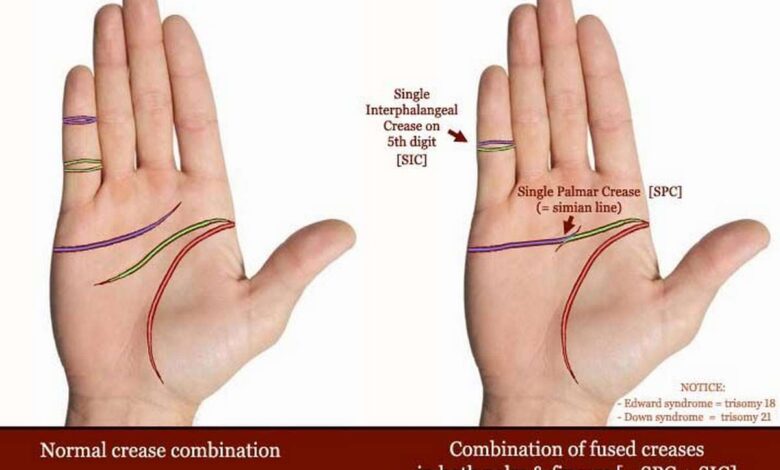Line simian, single transverse palmar crease: What's it, causes, symptoms, diagnostics, treatment, prevention

Single palmar crease; Transverse palmar crease; Palmar crease; Simian crease
Line simian, also known as single transverse palmar crease, is an anatomical sign of the hand, in which the line of life and the line of the head are combined and form one horizontal line.
The older term "monkey fold" is no longer used., because it tends to be negative.
This phenomenon may be associated with certain medical conditions and may attract the attention of physicians and patients..
What is a simian line?
Line simian – this is an anomaly of the lines on the palm, in which the line of life and the line of the head are combined and form one horizontal line. There are usually three main lines in the palm of a person.: heart line, head line and life line. However, the simian line can lead to the absence or combination of the head and life lines into one..
Causes of the Simian Line
Having a single palmar crease is often normal. However, it can also be associated with various conditions, affecting the mental and physical development of a person, including:
- Down's syndrome
- Syndrome Aarskoga
- Cohen syndrome
- fetal alcohol syndrome
- Trysomyya 13
- Rubella syndrome
- Syndrome Ternera
- Klinefelter Syndrome
- Pseudohypoparathyroidism
- crying cat syndrome
Symptoms of the Simian Line
The main symptom of the simian line is the union of the line of life and the line of the head into one horizontal line in the palm of your hand.. Other symptoms may include:
- Lack of separation between life and head lines.
- Increasing the horizontal line on the palm.
- Possible anomalies in the development of fingers and other parts of the hand.
When to see a doctor
If you or your child has a simian line or other abnormalities in the palm of your hand, should see a doctor, especially genetics or pediatrician. The doctor will conduct the necessary examination and give recommendations on further steps..
Questions, which the doctor may ask
An infant with a single palmar crease may have other symptoms and signs., that collectively define a particular syndrome or condition. Diagnosis of this condition is based on family history, medical history and complete medical examination.
Your healthcare provider may ask questions such as, as:
- Have a family history of Down syndrome or another disorder, associated with a single palmar crease?
- Does anyone else in the family have a solitary palmar crease with no other symptoms??
- Did the mother drink alcohol during pregnancy??
- What other symptoms are present?
Based on the answers to these questions, medical history and physical examination results may require further testing.
Diagnosis of the Simian line
Diagnosis of the simian lineage may include an analysis of the anatomy of the hand and an assessment of the lines on the palm. Additional genetic testing may be required to determine possible disorders.
Treatment of the Simian line
Line simian, usually, is an anatomical sign and does not require treatment. But, if the anomaly is associated with other medical conditions, the doctor can prescribe appropriate treatment.
Home Treatment
Home treatment is not required for the Simian line, since this is an anatomical sign and is not associated with the patient's lifestyle.
Simian line prophylaxis
Since the Simian lineage is usually associated with genetic and embryonic factors, there is no specific prophylaxis. However, a healthy lifestyle and pregnancy management as recommended by a doctor can help minimize the risk of anomalies..
In conclusion, simian line – it is an anatomical sign of the hand, which may be associated with various medical conditions. If you notice this anomaly, it is recommended to consult a doctor for diagnosis and consultation.
Used sources and literature
Jones KL, Jones MC, of Campo M. Recognizable patterns of malformation. In: Jones KL, Jones MC, of Campo M, eds. Smith’s Recognizable Patterns of Human Malformation. 8th ed. Philadelphia, PA: Elsevier; 2022:chap 1.
Knoll J, Forsyth R, Pryor S. Genetics: metabolism and dysmorphology. In: Kleinman K, Mcdaniel L, Molloy M, eds. The Harriet Lane Handbook. 22nd ed. Philadelphia, PA: Elsevier; 2021:chap 13.
Slavotinek AM. Dysmorphology. In: Kliegman RM, St. Geme JW, Bloom NJ, Shah SS, Tasker RC, Wilson KM, eds. Nelson Textbook of Pediatrics. 21st ed. Philadelphia, PA: Elsevier; 2020:chap 128.
